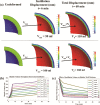Analyzing the effects of instillation volume on intravesical delivery using biphasic solute transport in a deformable geometry
- PMID: 29659860
- PMCID: PMC6563523
- DOI: 10.1093/imammb/dqy004
Analyzing the effects of instillation volume on intravesical delivery using biphasic solute transport in a deformable geometry
Abstract
Ailments of the bladder are often treated via intravesical delivery-direct application of therapeutic into the bladder through a catheter. This technique is employed hundreds of thousands of times every year, but protocol development has largely been limited to empirical determination. Furthermore, the numerical analyses of intravesical delivery performed to date have been restricted to static geometries and have not accounted for bladder deformation. This study uses a finite element analysis approach with biphasic solute transport to investigate several parameters pertinent to intravesical delivery including solute concentration, solute transport properties and instillation volume. The volume of instillation was found to have a substantial impact on the exposure of solute to the deeper muscle layers of the bladder, which are typically more difficult to reach. Indeed, increasing the instillation volume from 50-100 ml raised the muscle solute exposure as a percentage of overall bladder exposure from 60-70% with higher levels achieved for larger instillation volumes. Similar increases were not seen for changes in solute concentration or solute transport properties. These results indicate the role that instillation volume may play in targeting particular layers of the bladder during an intravesical delivery.
Keywords: FEBio; bladder cancer; cystitis; intravesical delivery.
© The Author(s) 2018. Published by Oxford University Press on behalf of the Institute of Mathematics and its Applications. All rights reserved.
Figures








References
-
- American Cancer Society (2016) Cancer Facts & Figures 2016. Atlanta: American Cancer Society.
Publication types
MeSH terms
Grants and funding
LinkOut - more resources
Full Text Sources
Other Literature Sources
Medical

